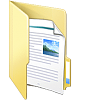How to Change the Name of "My Documents" without Renaming the Folder
If you have multiple users on your machine, and you have moved their "My Documents" folders to a secondary drive (as shown in Option Two of the "How to Change the Default Location of Windows 7 User Folders" tutorial, then you might end up with a scenario where you see multiple copies of "My Documents" within Windows Explorer.
If you haven't already done so, move the "My Documents" folders for all your users to (for example) the following locations on another drive:
FThis tutorial aims to show you how this problem can be resolved, in order to allow you to differenciate which one belongs to which user.
- D:\User1Docs
- D:\User2Docs
- D:\User3Docs
For clarification, the tutorial uses the following protocol:Now, let's get started truly customizing. For the purposes of this tutorial, I'll be using my "My Documents" and "My Pictures", but also only because I don't have multiple users setup on my rig, but the principle remains the same.
- Blue text denotes a command that must be typed in, for example DIR /ad.
- Red text denotes a key or key sequence, for example <WINDOWS_KEY>+<R>.
- Close all open Windows Explorer views
- Open an Elevated Command Prompt. (The command prompt doesn't have to be elevated, but the elevation is required to override permissions if you're doing this for multiple users.)
- In the command prompt window, type D: and press <ENTER>. Change the drive letter D to whatever the drive is on which the folders are located.
- type CD \User1Docs and press <ENTER>. (Substitute User1Docs for the actual folder name of "My Documents". If the name contains spaces, enclose it in quotes, for example CD "\User 1 Docs")
- type ATTRIB -S -R -H DESKTOP.INI and press <ENTER>
- type NOTEPAD DESKTOP.INI and press <ENTER>
- Press <CTRL>+<P> and print a copy of the DESKTOP.INI file for reference, in case you want to change the display name back to the default "My Documents"
- Change the value of "LocalizedResourceName=" to whatever you want. In the screenshots below, I used "These are Peter's Documents!"
- Close Notepad, and save changes
- Go back to the Command Prompt
- type ATTRIB +S +R +H DESKTOP.INI and press <ENTER>
- Repeat steps 3 to 11 for the other user's "My Documents" folders
- When you're done, type EXIT and press <ENTER>
- Open Window Explorer, navigate to your D:, and presto, a custom display name for "My Documents", as shown in the following screenshots:
Before editing DESKTOP.INI
Although this does work, it may be better if you rather created "root" folders for each user, and move their respective "Documents", "Pictures", "Videos", etc there. For Example:
And then have each folder within the "roots" you created, for example:
- D:\User1
- D:\User2
- D:\User3
I hope that you found this tutorial informative.
- D:\User1\Documents
- D:\User1\Pictures
My Documents - Personalize the Name

My Documents - Personalize the Name
How to Change the Name of "My Documents" without Renaming the FolderPublished by Dzomlija
Related Discussions



